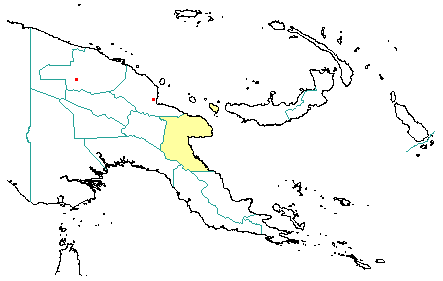
in PNGplants database
PNGTreesKey – Artocarpus altilis (Parkinson) Fosberg |
Barry Conn (NSW) & Kipiro Damas (LAE).
Guide to trees of Papua New Guinea
Copyright held by the authors, National Herbarium of New South Wales, and Papua New Guinea National Herbarium
Journal of the Washington Academy of Science Vol. 31: 95 (1941)
Family: Moraceae
Dicotyledon
Timber Group: Non-timber species Tradename: Breadfruit
Field Characters: Large canopy tree (up to 27 m high); Bole cylindrical (up to c. 60 cm diam., rarely up to c. 100 cm); straight (bole up to c. 10 m long, often only 1 or 2 m long); buttresses buttresses absent or buttresses present (often buttresses up to 1 m long); spines spines absent; aerial roots aerial roots absent; stilt roots stilt roots absent; Bark brown or grey, slightly rough, pustular, lenticels elongated vertically; less than 25 mm thick, 15.0 (c.); bark blaze consisting of one layer; faintly to non-aromatic; outer blaze pale yellow, markings absent; inner blaze pale yellow, markings absent; bark exudate (sap) present, white/milky, flowing, colour not changing on exposure to air, sticky; terminal buds not enclosed by leaves.
Indumentum: Complex hairs absent; stinging hairs absent; mature twig indumentum (hairs) absent.
Leaves: Leaves clustered at end of branches, spiral (leaves occurring singly at a node and arranged spirally up the branchlet), simple (a leaf composed of a single blade); petiole present, not winged, attached to base of leaf blade, not swollen; leaves broadest at or near middle, 30.0 cm, 30.0 cm; symmetric, entire, not dissected or lobed when young or often dissected or lobed, pinnately lobed (with 5-11 pairs of lobes), rounded, venation pinnate, secondary veins open, prominent, intramarginal veins absent; leaves lower surface green, upper surface dark green, indumentum (hairs) absent; absent; domatia absent; stipules present, free, laterally placed, not encircling the twig, leafy, not fringed, large (50-60 mm long), less often persistent or not persistent.
Flowers: Inflorescence axillary, flowers on an unbranched axis (male inflorescences drooping and club-shaped) or flowers arising from a single point (female inflorescences stiffly upright, globose or cylindrical), cones absent; flowers unisexual, unisexual with male and female flowers on the same plant, not stalked, flowers slightly asymmetric, 1.0 (c.) mm long, diameter small (up to10 mm diam.) (up to 1 mm diam.); perianth absent; stamens 1 (male flowers), absent (female flowers) or present (male flowers), free of each other; ovary inferior, carpels joined (when more than one), locules 1-2; styles absent or very short solitary, 1 (with 2 long stigmas).
Fruits: Infrutescence single (multiple fruit) or arising from single point ('fruitlets'), fruit 100.0-500.0 mm long, 30.0-40.0 mm diam., green, not spiny, fleshy, multiple (syncarp), indehiscent, drupe (drupes clustered together to form a syncarp - the large central core of the fruit is surrounded by many abortive flowers which form a pale yellow juicy pulp; the edible portion of the fruit); seeds 20-60, much more than 10 mm long (20-25 mm long), not winged, narrow (longer than wide), seed more than 10 mm diam.
Distribution: Morobe.
 | Botanical records in PNGplants database |
Notes: Notes Previously known as Artocarpus incisus L.f. or Artocarpus communis J.R.Forst. & G.Forst. This species is frequently cultivated for its edible fruits.